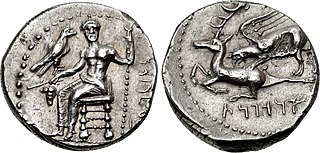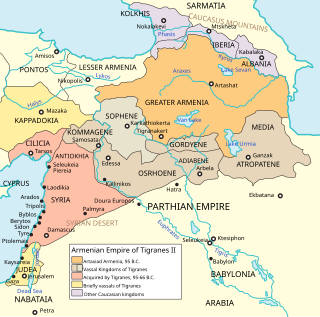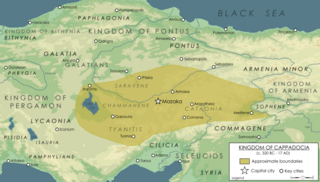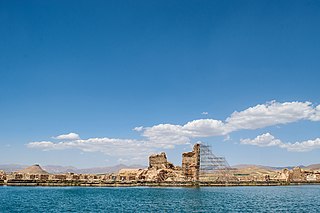Related Research Articles

Ardashir II, was the Sasanian King of Kings of Iran from 379 to 383. He was the brother of his predecessor, Shapur II, under whom he had served as vassal king of Adiabene, where he fought alongside his brother against the Romans. Ardashir II was appointed as his brother's successor to rule interimly till the latter's son Shapur III reached adulthood. Ardashir II's short reign was largely uneventful, with the Sasanians unsuccessfully trying to maintain rule over Armenia.

Arsaces I was the first king of Parthia, ruling from 247 BC to 217 BC, as well as the founder and eponym of the Arsacid dynasty of Parthia. The leader of the Parni, one of the three tribes of the Dahae confederacy, Arsaces founded his dynasty in the mid-3rd century BC when he conquered the satrapy of Parthia from Andragoras, who had rebelled against the Seleucid Empire. He spent the rest of his reign consolidating his rule in the region, and successfully stopped the Seleucid efforts to reconquer Parthia. Due to Arsaces' achievements, he became a popular figure amongst the Arsacid monarchs, who used his name as a royal honorific. By the time of his death, Arsaces had laid the foundations of a strong state, which would eventually transform into an empire under his great-grandnephew, Mithridates I, who assumed the ancient Near Eastern royal title of King of Kings. Arsaces was succeeded by his son Arsaces II.

Atropatene, also known as Media Atropatene, was an ancient Iranian kingdom established in c. 323 BC by the Persian satrap Atropates. The kingdom, centered in present-day northern Iran, was ruled by Atropates' descendants until the early 1st-century AD, when the Parthian Arsacid dynasty supplanted them. It was conquered by the Sasanians in 226, and turned into a province governed by a marzban ("margrave"). Atropatene was the only Iranian region to remain under Zoroastrian authority from the Achaemenids to the Arab conquest without interruption, aside from being briefly ruled by the Macedonian king Alexander the Great.

The Kambojas were a southeastern Iranian people who inhabited the northeastern most part of the territory populated by Iranian tribes, which bordered the Indian lands. They only appear in Indo-Aryan inscriptions and literature, being first attested during the later part of the Vedic period.

Phraates IV was King of Kings of the Parthian Empire from 37 to 2 BC. He was the son and successor of Orodes II, and was given the throne after the death of his brother Pacorus I. Phraates IV soon murdered all his brothers, and also possibly his father. His actions alienated the Armenians and also some of his nobles, including the distinguished Monaeses, who fled to the Roman triumvir Mark Antony, but shortly returned and reconciled with Phraates IV.
Hydarnes, also known as Hydarnes the Elder, was a Persian nobleman, who was one of the seven conspirators who overthrew the Pseudo-Smerdis. His name is the Greek transliteration of the Old Persian name Vidṛna, which may have meant "he who knows the guilt/wrong".

Jamasp was Sasanian King of Kings of Iran from 496 to 498/9. He was a son of Peroz I and younger brother of Kavad I. Jamasp was installed on the Sasanian throne upon the deposition of the latter by the nobility and clergy.

The Farāvahār, also called the Foruhār (فروهر) or the Fārre Kiyâni, is one of the most prominent symbols of Zoroastrianism. There is no universal consensus on what it means or stands for, as a variety of interpretations exist. The most common belief is that it depicts the fravaṣ̌i, which is the Zoroastrian concept of the monotheistic god in Zoroastrianism.

Ariarathes IV, surnamed Eusebes, "the Pious",, was the king of Cappadocia in 220–163 BC.

Ariaramnes, was the Ariarathid king of Cappadocia from 280 BC to 230 BC. He was the son and successor of Ariarathes II.

Ariarathes II, satrap and king of Cappadocia, son of Holophernes, fled into Armenia after the death of his uncle and adopted father Ariarathes I, ruler of Cappadocia. After the death of Eumenes he recovered Cappadocia with the assistance of Ardoates, the Armenian king, and killed Amyntas, the Macedonian satrap, in 301 BC, but was forced to accept Seleucid suzerainty. He was succeeded by Ariaramnes, the eldest of his three sons.

Ariarathes I was the last Achaemenid Persian governor (satrap) of the province (satrapy) of Northern Cappadocia, serving from the 340s BC to 331 BC. He led defensive efforts against the Macedonian invasion, commanded by Alexander the Great, and later fought at the Battle of Gaugamela under Darius III, the last King of Kings of the Achaemenid Empire. After the fall of the Achaemenid Empire, Ariarathes continued his resistance against the Macedonians, ruling concomitantly as an Achaemenid remnant and a precursor to the Kingdom of Cappadocia. He is regarded as the founder of the Iranian Ariarathid dynasty.

Istakhr was an ancient city in Fars province, five kilometres north of Persepolis in southwestern Iran. It flourished as the capital of the Persian Frataraka governors and Kings of Persis from the third century BC to the early 3rd century AD. It reached its apex under the Sasanian Empire, and was the hometown of the Sasanian dynasty. Istakhr briefly served as the first capital of the Sasanian Empire from 224 to 226 AD and then as principal city, region, and religious centre of the Sasanian province of Pars.

The Kingdom of Sophene, was a Hellenistic-era political entity situated between ancient Armenia and Syria. Ruled by the Orontid dynasty, the kingdom was culturally mixed with Greek, Armenian, Iranian, Syrian, Anatolian and Roman influences. Founded around the 3rd century BCE, the kingdom maintained independence until c. 95 BCE when the Artaxiad king Tigranes the Great conquered the territories as part of his empire. Sophene laid near medieval Kharput, which is present day Elazığ.
Artasyrus was a Bactrian nobleman in the Achaemenid Empire, who was the father of Orontes I, the satrap of the Armenia and ancestor of the Orontid dynasty. The career of Artasyrus is obscure. According to the Greek historian Plutarch, he held the high-ranking office of the "King's Eye". He has been suggested be the same person as the namesake Iranian noble who participated in the Battle of Cunaxa in 401 BC. He and Orontes I are the only Bactrians who are known to have occupied high offices under the Achaemenid Empire. Bactrians that settled in other parts of the empire either did so by their own will or as garrison-colonists.

Cappadocia was a Hellenistic-era Iranian kingdom centered in the historical region of Cappadocia in Asia Minor. It developed from the former Achaemenid satrapy of Cappadocia, and it was founded by its last satrap, Ariarathes. Throughout its history, it was ruled by three families in succession; the House of Ariarathes (331–96 BC), the House of Ariobarzanes (96–36 BC), and lastly that of Archelaus (36 BC–17 AD). In 17 AD, following the death of Archelaus, during the reign of Roman emperor Tiberius (14–37 AD), the kingdom was incorporated as a Roman province.

Adur Gushnasp was the name of a Zoroastrian sacred fire of the highest grade, which served as one of the three most sacred fires of pre-Islamic Iran; the two others being the Adur Farnbag and Adur Burzen-Mihr. Out of the three, Adur Gushnasp is the only fire whose temple structure has been discovered and "for which archaeological, sigillographical, and textual evidence are all available."

The Cappadocian calendar was a solar calendar that was derived from the Persian Zoroastrian calendar. It is named after the historic region Cappadocia in present-day Turkey, where it was used. The calendar, which had 12 months of 30 days each and five epagomenal days, originated between 550 and 330 BC, when Cappadocia was part of the Persian Achaemenid Empire. The Cappadocian calendar was identical to the Zoroastrian calendar; this can be seen in its structure, in the Avestan names and in the order of the months. The Cappadocian calendar reflects the Iranian cultural influence in the region. Extant evidence of the calendar dates back to Late Antiquity through the accounts of Greek astronomers, by which time it had already been adapted to the Julian calendar.
The Temple of Anahita was an ancient fire temple in Istakhr dedicated to the worship of the Iranian goddess Anahid.
References
- ↑ McGing 2012 , p. 151; Weiskopf 1990 , pp. 780–786; Shahbazi 1986 , pp. 410–411; Boyce & Grenet 1991 , pp. 266–267, 281; Mørkholm 1991 , p. 96.